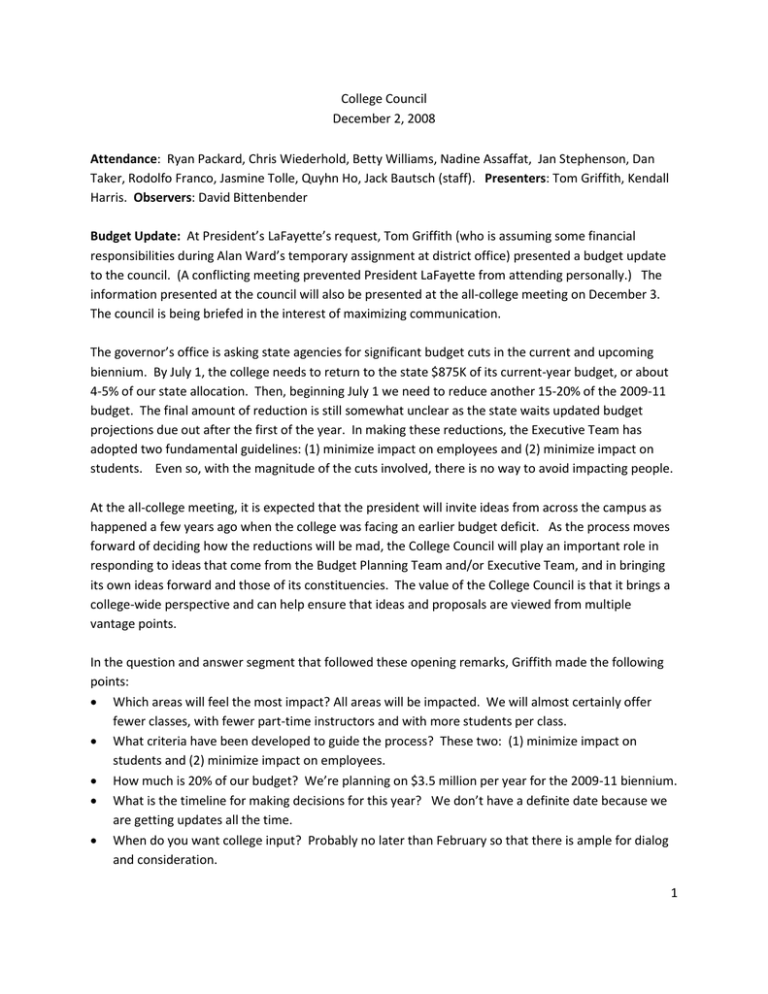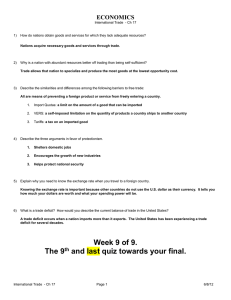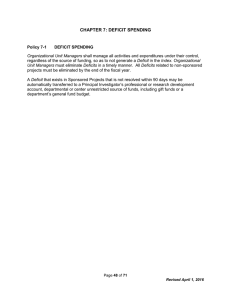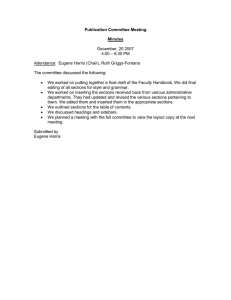College Council December 2, 2008 Presenters
advertisement

College Council December 2, 2008 Attendance: Ryan Packard, Chris Wiederhold, Betty Williams, Nadine Assaffat, Jan Stephenson, Dan Taker, Rodolfo Franco, Jasmine Tolle, Quyhn Ho, Jack Bautsch (staff). Presenters: Tom Griffith, Kendall Harris. Observers: David Bittenbender Budget Update: At President’s LaFayette’s request, Tom Griffith (who is assuming some financial responsibilities during Alan Ward’s temporary assignment at district office) presented a budget update to the council. (A conflicting meeting prevented President LaFayette from attending personally.) The information presented at the council will also be presented at the all-college meeting on December 3. The council is being briefed in the interest of maximizing communication. The governor’s office is asking state agencies for significant budget cuts in the current and upcoming biennium. By July 1, the college needs to return to the state $875K of its current-year budget, or about 4-5% of our state allocation. Then, beginning July 1 we need to reduce another 15-20% of the 2009-11 budget. The final amount of reduction is still somewhat unclear as the state waits updated budget projections due out after the first of the year. In making these reductions, the Executive Team has adopted two fundamental guidelines: (1) minimize impact on employees and (2) minimize impact on students. Even so, with the magnitude of the cuts involved, there is no way to avoid impacting people. At the all-college meeting, it is expected that the president will invite ideas from across the campus as happened a few years ago when the college was facing an earlier budget deficit. As the process moves forward of deciding how the reductions will be mad, the College Council will play an important role in responding to ideas that come from the Budget Planning Team and/or Executive Team, and in bringing its own ideas forward and those of its constituencies. The value of the College Council is that it brings a college-wide perspective and can help ensure that ideas and proposals are viewed from multiple vantage points. In the question and answer segment that followed these opening remarks, Griffith made the following points: Which areas will feel the most impact? All areas will be impacted. We will almost certainly offer fewer classes, with fewer part-time instructors and with more students per class. What criteria have been developed to guide the process? These two: (1) minimize impact on students and (2) minimize impact on employees. How much is 20% of our budget? We’re planning on $3.5 million per year for the 2009-11 biennium. What is the timeline for making decisions for this year? We don’t have a definite date because we are getting updates all the time. When do you want college input? Probably no later than February so that there is ample for dialog and consideration. 1 Will the deepest cuts for this year come in spring quarter? We have already identified about $600K of the required $875 reduction for this year. We are looking at carry-forward funds from last year, vacant positions, lapsed salaries and curtailed travel. Instruction will be looking closely at lowenrolled classes in both winter and spring quarters. Any layoffs will be for next year. What is the state policy about our contingency fund? Honest, I do not know. I do know that the state has asked us to report any balances in various funds. This has caused some concern because in the past the state has used that information to reduce allocations. I hope the state leaves the reserve so we can buffer the impact of the cuts. If we have recommendations, where do we take them? Either to the College Council or to the Budget Planning Team. Food Services: Kendall Harris, Director of Business Enterprises, was present at the council’s request to discuss the state of food services on campus. The topic arose from discussions at the previous council meeting. Harris began by providing some historical information. Food services used to be part of an instructional culinary arts program. When that program was moved to Seattle Central, North was left with an autonomous service to provide food. Two summers ago (Summer 2007) some major changes occurred when the culinary arts area was remodeled to accommodate Work Source’s move to campus, long-time chef John Rost retired to be replaced by Shannon Jepson, and the espresso lounge area was created. Food services opened in fall 2007 with three venues: the cafeteria (with abbreviated food offerings, the Munch Mart, and the espresso lounge and a new manager. By the end of the 2007-08 year, the operation had accumulated an annual deficit of $200K. (North is not unique in this regard. Of all the local colleges polled, Renton Technical College is the only one not losing money on its food service operations) Both the cafeteria and the Munch Mart were in deficit positions; the espresso lounge was the only profitable operation. In Summer 2008, when the employee within the Munch Mart retired, it was decide to renovate that area to accommodate vending machines only. It immediately became profitable. In the current year (2008-09), the espresso lounge has risen in popularity. Food services revenue base is 17-18% higher this year than last, due to the profitability of the espresso lounge and the new vending area. When Shannon Jepson resigned in fall quarter, his position was not filled. Two employees--the chief cook and the fiscal agent—have done an outstanding job in managing the operation such that there is much better information and control over the supply change, inventory, what is selling, what is not selling, etc. Harris reported that the college has a better “handle of things” now than ever before. The dilemma that the college faces is this: we must provide students food, but we also have to solve the deficit situation. The goal is to break even. To assist us, the college contracted with Sodexo to provide us consultation on the operation. (Note: While Sodexo provides food services, our contract with them was for an evaluation of how we are doing and for ideas on what we could do to increase effectiveness and efficiency.) Earlier this fall they conducted a survey and several focus groups asking about the pluses and minuses of current food services and recommendations for improvement. Their report is 2 expected should arrive any day now. From Harris’ conversations with the consultants, the report is expected to contain helpful suggestions. In the question and answer segment that followed these remarks, Harris made the following points: Many of our food services workers are students: WorkFirst, WorkSource, or work-study students. Hiring them is very economical. Could “theme nights” in the cafeteria help the situation? Yes, they could. They are a good idea. The effort and labor to organize and market there is where we would need help. Food services can do the menu, but others are needed to help promote the events. How large is the deficit in food services? About $400K. With whom did Sodexo conduct focus groups? They talked to three or four student groups, classified and exempt staff, the Executive Team, faculty groups, and food service staff. There were open-ended questions about likes/dislikes and also questions about how much you spend each day, per meal, etc. There was an on-line survey as well. One of the ideas that they suggested was to make the student ID card a cash-card as well. Students reportedly responded very favorably to that idea. Has the introduction of credit cards helped sales in food services? Yes, tremendously! Could we out-source food services? Yes, we could do that, but would have to work through negotiated contract issues first. But, do we want to do that? If we contract, the facility is turned over the contractor. Catering costs would go up, and food services costs may well go up, too. It may help with our fiscal challenge, but would the service be better? That’s the question we would have to answer before going in that direction. Approval of minutes: The minutes from the October 21, 2008 and November 18, 2008 council meetings were approved without modification. Moving Ahead: Ryan indicated he would talk to the Budget Planning Team to make sure it is clear how College Council can provide its input into that group’s deliberations. A short discussion ensued about the pros and cons of various taxing options the state might consider to address the deficit. Adjournment: The meeting adjourned at 4:20 Minutes by Jack Bautsch 3



